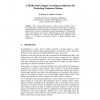8 search results - page 1 / 2 » A divide-and-conquer learning architecture for predicting un... |
ESANN
2001
13 years 6 months ago
2001
Time varying environments or model selection problems lead to crucial dilemmas in identification and control science. In this paper, we propose a modular prediction scheme consisti...
ICPR
2002
IEEE
13 years 9 months ago
2002
IEEE
This paper describes a novel application of Statistical Learning Theory (SLT) for motion prediction. SLT provides analytical VC-generalization bounds for model selection; these bo...
BMCBI
2010
13 years 4 months ago
2010
Background: MicroRNAs (miRNAs) play an essential task in gene regulatory networks by inhibiting the expression of target mRNAs. As their mRNA targets are genes involved in importa...
IJCAI
1997
13 years 5 months ago
1997
Psychological experiments on children's development of spatial knowledge suggest experience at self-locomotion with visual tracking as important factors. Yet, the mechanism u...
ECAI
2006
Springer
13 years 8 months ago
2006
Springer
This work presents some anticipatory mechanisms in an agent architecture, modeling affective behaviours as effects of surprise. Through experiment discussion, the advantages of bec...

